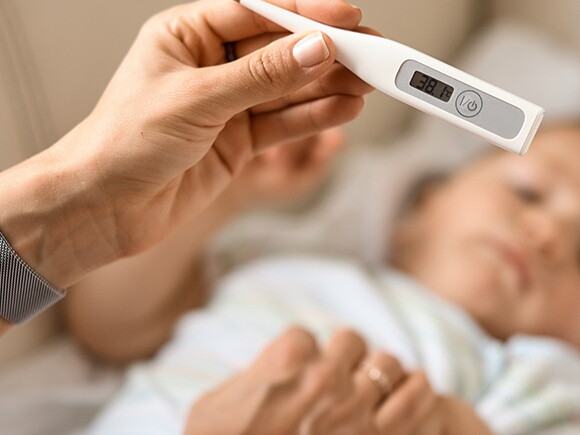
When to worry about fever in babies and children
What exactly is a fever?1
- A fever is when your body temperature rises above 38°Celsius (38°C), and it's usually a sign of an illness.
- For babies, their average body temperature is around 36.5°C to 38°C, so if their temperature goes beyond 38°C, it's considered a fever.
What Causes Fever (High Temperature)?2
- When children have a fever or high temperature, it's usually because of an infection. The fever helps the body by stimulating the immune system to fight the infection and makes it harder for germs to grow.
- Common conditions that can cause fevers include:3
- upper respiratory tract infections (RTIs)
- flu
- ear infections
- roseola – a virus that causes a temperature and a rash
- tonsillitis
- kidney or urinary tract infections (UTIs)
- common childhood illnesses, such as chickenpox and whooping cough
- Common conditions that can cause fevers include:3
- There are a few other reasons why children may get a fever. For instance,
- Infants, especially newborns, may get fevers if they are dressed too warmly or are in a hot environment since they don't regulate their body temperature as well as older kids. Still, if a newborn is overdressed and has a fever, it's essential to have them checked by a doctor since it may be a sign of a severe infection.
- Sometimes, babies and children can get a mild fever that lasts about a day after getting vaccinated.
- Also, if a child is teething, they may experience a slight rise in body temperature, but this is usually not the cause if the temperature is higher than 100°F (37.8°C).
When to worry about fever?3
If your child experiences any of the following symptoms, you should call an emergency immediately:
- Stiff neck
- Rash that does not fade when you press a glass against it (use the 'glass test' from Meningitis Now)
- Sensitivity to light
- First-time fit (febrile seizure) causing uncontrollable shaking
- Unusually cold hands and feet
- Blue, pale, or blotchy skin, lips, or tongue
- Weak, high-pitched cry that is not like their normal cry
- Drowsiness and difficulty waking up
- Extreme agitation (does not stop crying) or confusion
- Difficulty breathing and sucking their stomach in under their ribs
- Not responding as they normally would, or not interested in feeding or normal activities.
Just remember to contact your GP if your child is experiencing any of the following:
- If your child is under 3 months old and their temperature is 38°C (101°F) or higher.
- If your child is over 3 months old and their temperature is 39°C (102°F) or higher.
- If your child has a high temperature that has lasted for 5 days or more.
- If your child is experiencing persistent vomiting.
- If your child is feeling unwell, refusing to eat or drink, or if they're acting unusual, and you're concerned.
- If your child has a high temperature that doesn't seem to go down with paracetamol.
- If your child is showing signs of dehydration - this can be indicated by dry nappies, sunken eyes, and no tears when they're crying.
- If your child has a rash in addition to a high temperature.
However, if your child seems to be otherwise well - for example, if they're playing and attentive - it's less likely that they're seriously ill. Keep an eye on them, give them plenty of love and attention, and they'll be feeling better in no time!
What to do if your child has a high temperature4
If your child or baby has a high temperature, you can usually take care of them at home. In most cases, the temperature should go down over 1 to 4 days. Here are some things you should do and avoid:
Do:
- Give them plenty of fluids. If your baby is breastfed, continue to breastfeed as normal.
- Look out for signs of dehydration.
- Give them food if they want it.
- Check on your child regularly, including during the night.
- Keep them at home.
- Give them paracetamol or ibuprofen if they're distressed or uncomfortable. Check the packaging or leaflet to make sure the medicine is suitable for your child, or speak to a pharmacist or GP if you're not sure.
- Get medical advice if you're worried about your child.
Don't:
- Undress your child or sponge them down to cool them. A high temperature is a natural and healthy response to infection.
- Cover them up in too many clothes or bedclothes.
- Give aspirin to children under 16 years of age.
- Combine ibuprofen and paracetamol, unless a GP tells you to.
- Give paracetamol to a child under 2 months.
- Give ibuprofen to a child who is under 3 months, weighs under 5kg, has chickenpox, or is dehydrated.
- Give ibuprofen to children with asthma unless it's been recommended by a doctor.
Resources:
- Fever in babies. The Australian Government. Last reviewed: October 2022. Available at: https://www.pregnancybirthbaby.org.au/fever-in-babies#what-is. Last accessed at: 23.03.2024.
- Fever (High Temperature) In Kids. The Nemours Foundation. Date reviewed: November 2022. Available at: https://kidshealth.org/en/parents/fever.html. Last accessed at: 23.03.2024.
- Fever in children. NHS inform. Last updated: 29 May 2023. Available at: https://www.nhsinform.scot/illnesses-and-conditions/infections-and-poisoning/fever-in-children/. Last accessed at: 23.03.2024.
- High temperature (fever) in children. NHS. Page last reviewed: 03 January 2024. Available at: https://www.nhs.uk/conditions/fever-in-children/. Last accessed at: 23.03.2024.